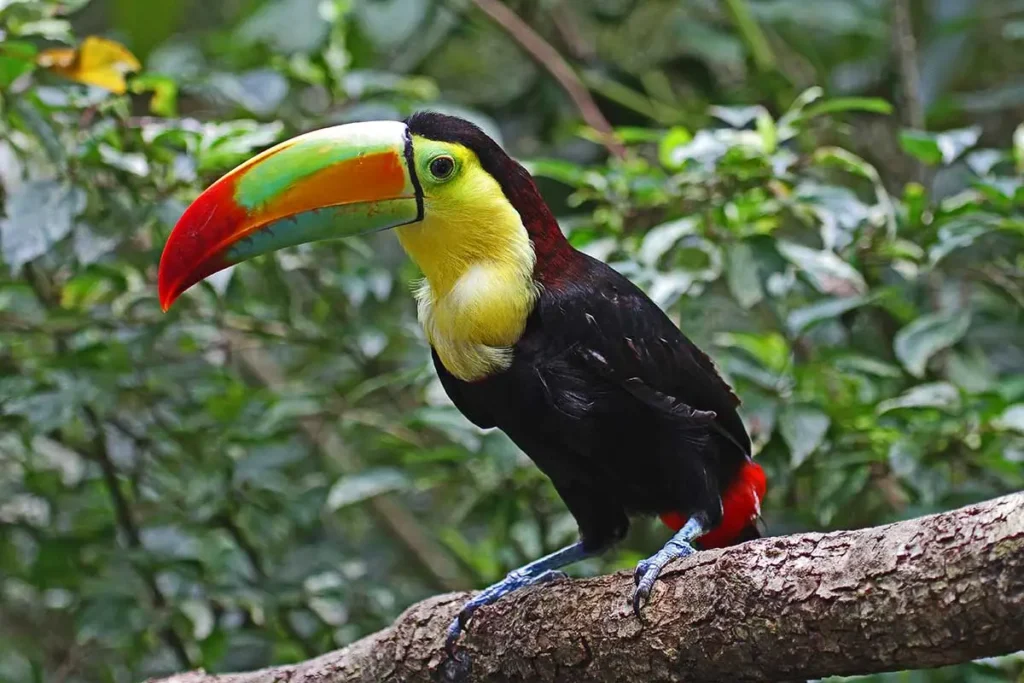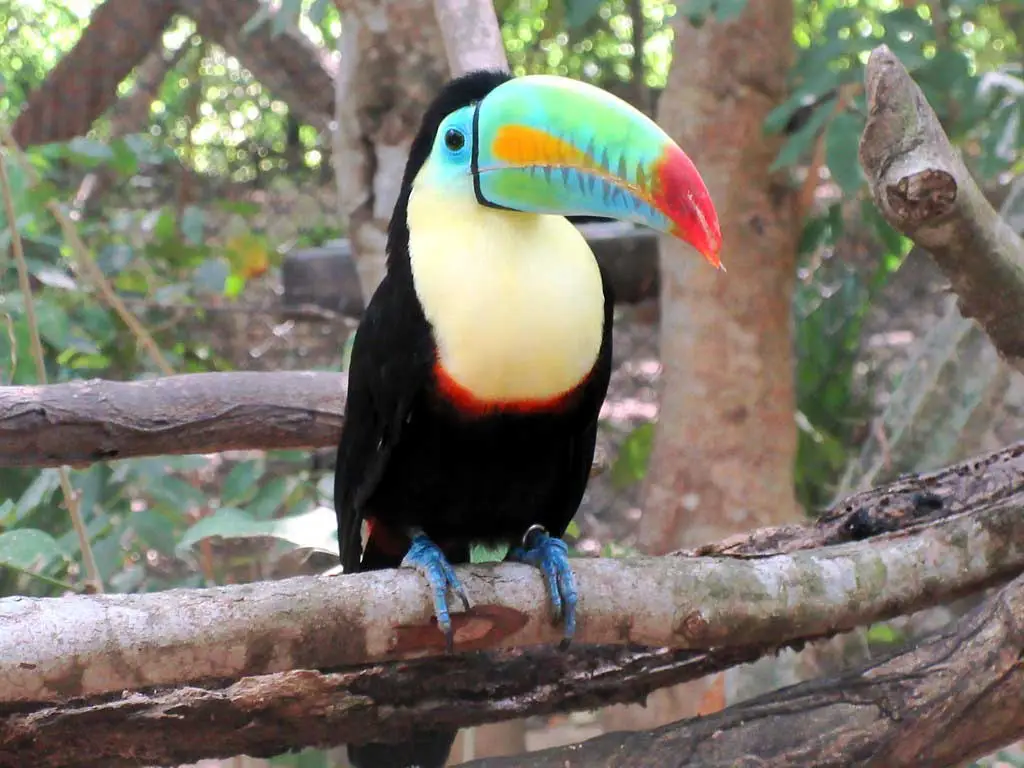
The Keel-Billed Toucan (Ramphastos sulfuratus), also known as the sulfur-breasted toucan, rainbow-billed toucan, keel toucan or just toucan ramphastos, is a remarkable and colorful forest bird found in the lush jungles of Latin America. Belonging to the Kingdom Animalia, this bird species is a member of the toucan family (Ramphastidae) and is known for its vibrant colors and striking appearance.

Fascinating Facts about Keel-Billed Toucan
- The Keel-Billed Toucan is the national bird of Belize.
- The oversized bill of the toucan ramphastos is made of keratin. This protein keratin is the same material found in human hair and nails.
- Keel-Billed Toucans have zygodactyl feet, meaning two toes face forward, and two toes face backward.
Physical Appearance and Features
The Unique Bill of Keel-Billed Toucan
The most striking feature of the Keel-Billed Toucan is its large, colorful bill. The bill is made of lightweight bone covered in keratin and can reach up to one-third of the bird’s total body length. The bill’s vibrant colors include shades of green, orange, red, and blue, and its unique shape serves various purposes, from feeding to social displays. An amazing bill, no doubt.

The vivid colors of toucan ramphastos
In addition to their colorful bill, Keel-Billed Toucans have bright, eye-catching plumage. Their feathers are mainly black, with a bright yellow chest and a red patch near the tail. The skin around their eyes is a striking blue, and their feet are a mix of blue and orange.
Size and Weight of Keel-Billed Toucan
Keel-Billed Toucans are medium-sized birds, with a body length of about 42-55 cm (16.5-21.6 inches) and a weight of around 380-500 grams (13.4-17.6 ounces). Their wingspan is relatively short compared to their body size, which results in rapid wing beats and limited gliding ability during flight.
Distribution and Habitat
Keel-Billed Toucans, as other toucan species such as the emerald toucanet, are native to the lowland rainforests of Southern Mexico, Belize (where it is the national bird), Colombia, Venezuela, and Costa Rica.
They inhabit the forest canopy and are particularly drawn to areas with an abundance of fruiting trees. Keel-Billed Toucans can also be found in tree holes in mountain forests, although they are less common in these regions compared to their lowland counterparts.

Diet and Feeding Habits
The primary diet of Keel-Billed Toucans consists of fruit, with favorites including bananas and other tropical fruits. They use their long bills to reach for fruit on branches that are otherwise inaccessible to other birds.
Keel-Billed Toucans also consume insects, lizards, small snakes, and even the eggs and nestlings of other bird species. Interestingly, they swallow their fruit whole and then regurgitate the seeds, playing a crucial role in seed dispersal within their habitat.
Social Behavior and Communication
Keel-Billed Toucans are highly social birds that live in groups, often consisting of pairs or small family structures. They communicate with each other using a variety of calls, ranging from croaks to high-pitched yelps. These vocalizations help them coordinate their search for food, establish territory, and maintain social bonds within the group.

Reproduction and Nesting
During the breeding season, Keel-Billed Toucan pairs work together to find suitable tree cavities or holes for nesting, often selecting a tree cavity that has been naturally formed or created by woodpeckers.
Both parents share the responsibility of incubating the eggs and feeding the chicks, taking turns incubating to ensure the eggs are kept warm and protected. The female typically lays two to four eggs, and the incubation period lasts around 15-20 days. After hatching, the nestlings remain in the nest for about 6-8 weeks before fledging.
Threats and Conservation Status
Although the toucan ramphastos was listed as Least Concern on the IUCN Red List a few years ago, the reality is that it was last updated in 2021 and it is considered as a Near Threatened bird. The species faces threats such as habitat loss due to deforestation in different Latin American regions such as Southern Mexico, illegal pet trade, and hunting.
Additionally, their population size is declining in certain areas due to factors like iron storage disease, a condition that affects their ability to store and process protein. Conservation efforts, including habitat protection and regulation of the pet trade, are essential for the long-term survival of this captivating bird species.

Keel-Billed Toucan’s Role in the Ecosystem
As primarily fruit-eating birds, Keel-Billed Toucans play a significant role in their ecosystem by dispersing seeds throughout the forest canopy. This process helps maintain the diversity and health of their habitat, as it aids in the growth and regeneration of various plant species. The ramphastos sulfuratus are also part of the food chain, serving as both predators and prey for other animals in the forest.
Fun Facts about Keel-Billed Toucan
- Keel-Billed Toucans are known to toss fruit into the air and catch it in their mouths before swallowing it whole.
- Despite their large bills, Keel-Billed Toucans have a relatively small tongue.
- Keel-Billed Toucans regulate their body temperature by adjusting the blood flow to their bills.
- Their striking appearance has made them a popular subject in art, culture, and advertising.

Conclusions about Ramphastos sulfuratus
The Keel-Billed Toucan, a fascinating and vibrant forest bird, brings a touch of rainbow magic to the jungles of Latin America. With their unmistakable bills, vivid plumage, and captivating social behavior, these birds never fail to enchant those fortunate enough to encounter them. Renowned institutions such as the Cornell Lab of Ornithology have extensively studied this species, along with other members of the toucan family, like the elusive mountain toucans.
Their unique adaptations, such as nesting in tree cavities and their complex family structure, make them an interesting subject of research. Moreover, their ability to cover considerable flight distances contributes to their role as seed dispersers, ensuring the health of their ecosystem.
However, the Keel-Billed Toucan faces challenges, such as habitat loss and population decline, which organizations like BirdLife International are striving to address. By learning more about the Keel-Billed Toucan, also known as Ramphastos sulfuratus, and working to protect their habitat, we can help ensure that future generations can appreciate this remarkable bird species for years to come.
As we continue to discover new aspects of these birds, such as their vibrant blue feet and striking red feathers, our understanding and appreciation for their role in nature deepen. Together, we can safeguard the future of the Keel-Billed Toucan and protect the beauty and diversity of our world’s tropical forests.

